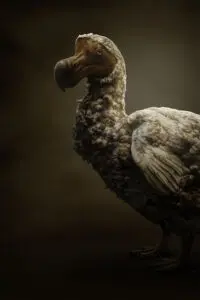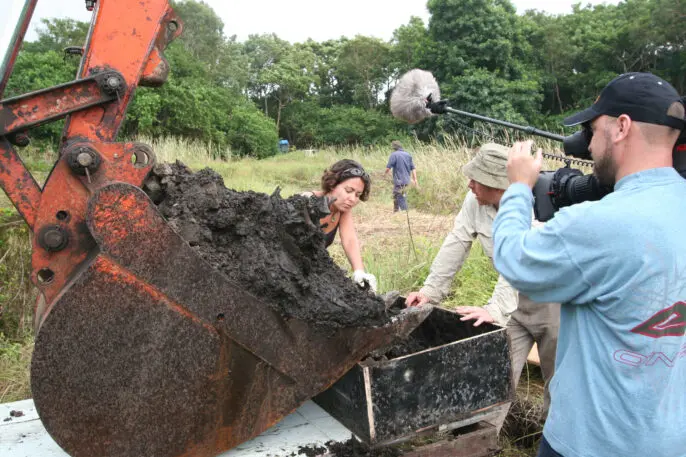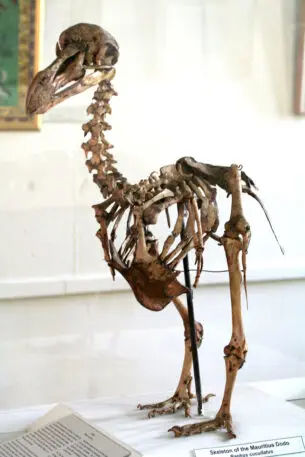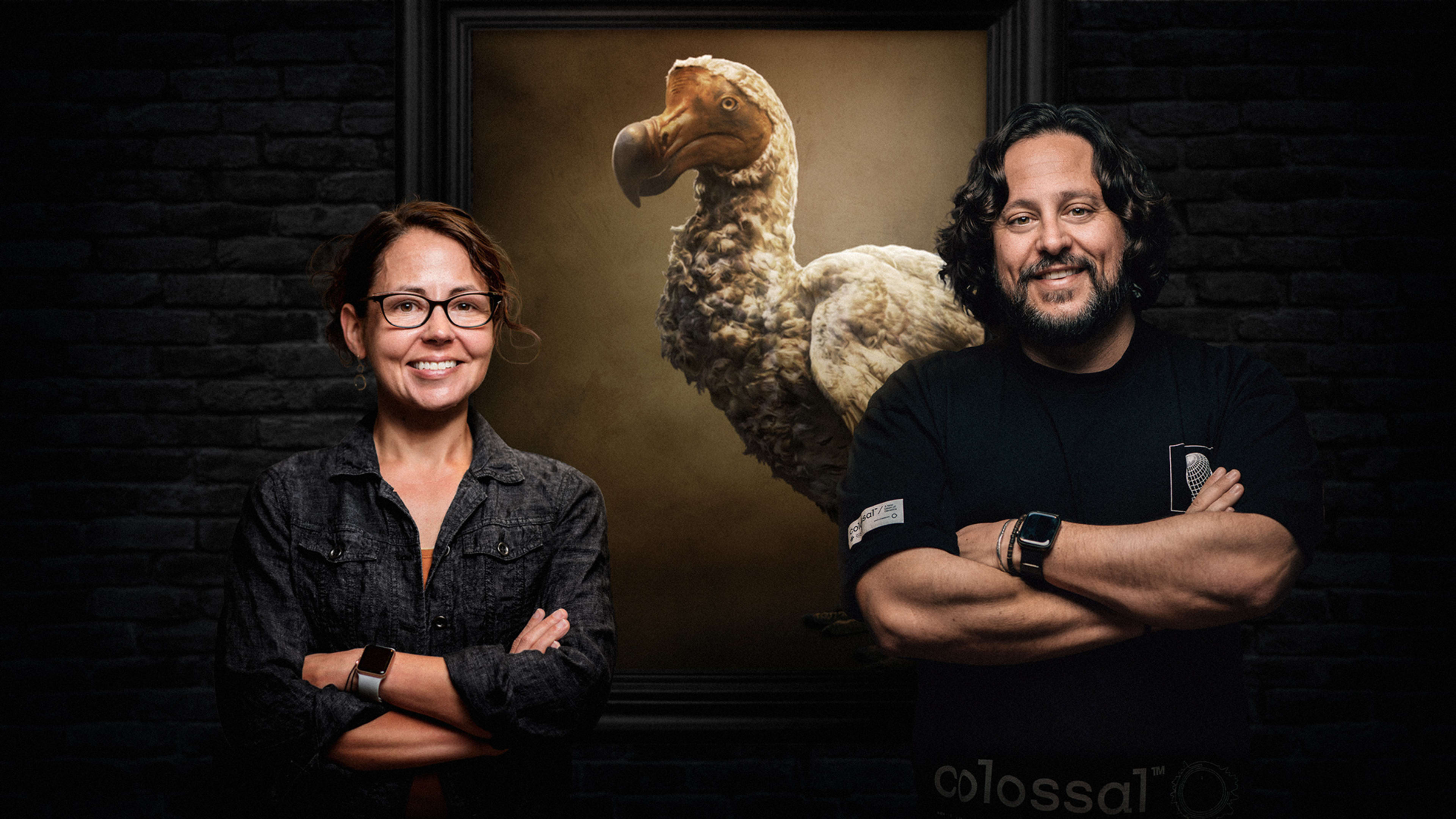The last living dodo bird was seen on the island of Mauritius in 1662; soon it was extinct, largely the victim of the invasive species humans brought to the island. But the dodo may one day see a second life: Using its genome and that of its closest living relative, the genomics company Colossal Biosciences plans to harness gene editing tools to bring the bird back from the dead.
“The Dodo is a prime example of a species that became extinct because we—people—made it impossible for them to survive in their native habitat,” says Beth Shapiro, a paleogeneticist and scientific adviser to Colossal, which is building technology to “de-extinct” animals. The goal, it says, is to combat biodiversity loss and restore ecosystems and climates that have degraded without them. The two-year-old, Dallas-based startup has already announced plans to resurrect the wooly mammoth, which could help keep arctic shrubs and trees under control and fertilize grasses with their manure, along with a resuscitated Tasmanian tiger, which helped keep ecosystems in Australia in balance until the early 20th century.

The dodo effort, led by a newly assembled Avian Genomics Group, will be aided by a new $150M Series B financing round. After the hard process of genetic engineering and assisted reproductive technologies, the aim is to work with the government of Mauritius on rewilding the bird in its former habitat.
Colossal CEO Ben Lamm estimated the first dodo would be born before the mammoth calves, which it aims to birth in 2028 using an artificial womb. “Given the significantly shorter timeline of gestation of 30 days versus the 22 months in elephants, I think it is highly likely we see a dodo before we see the mammoth,” he says.
The moonshot technology has attracted some $225 million from investors, many of whom come far from the world of biology: Paris Hilton, Chris Hemsworth, Tony Robbins, the Winkelvoss twins, video game developer Richard Garriott, and Thomas Tull, the founder of Legendary Pictures and the U.S. Innovative Technology Fund, have all invested. So, too, has In-Q-Tel, the CIA’s venture capital arm.
For those investors, at least for now, what’s most exciting about de-extinction is the hard path it takes to get there, and the benefits that may accrue along the way. Even without resurrecting extinct species, Colossal’s innovations in synthetic biology could be used to conserve existing wildlife. Animal populations have plunged by an average of 69% in the past half-century—including a decline of some three billion birds—a decline exacerbated by and that exacerbates climatic changes.
“If there are coral populations that are better able to survive in warm and more acidic water than others, and we can understand what those genetic underpinnings are, we can use these technologies to move those DNA sequences from the resistant coral populations to others, creating populations that are able to survive and thrive, even in this rapidly changing climate,” Shapiro says. The company is also working on synthesizing the elephant endotheliotropic herpesvirus, which infects and kills many young Asian elephants. Genetic technology “operates at a pace that allows these species to keep up, that gives them a chance to survive.”
The company also touts potential benefits in agriculture and in human healthcare, through improved gene therapy and vaccine development. There’s also geopolitical survival: its innovations, Colossal said in a statement, will help to “further the U.S. high tech advantage.” In September the company spun out its in-house software platform into a new startup, Form Bio, focused on “empowering scientists to reach discoveries and breakthroughs in less time and with less effort,” with $30 million in initial funding.
Lamm, a serial entrepreneur, first contacted genomics pioneer George Church in 2019 to discuss algae. Lamm was at the time leading Hypergiant, offering AI and consulting to aerospace and the military, It was there that Lamm helped develop a prototype for the Eos Bioreactor, a small box that uses software to manage the growth of algae, which naturally removes carbon dioxide from the air.
Church, who himself has cofounded some 50 companies through his Harvard lab, turned Lamm onto another idea, one meant to address both the climate and biodiversity crises. In September 2021, they launched Colossal with Lamm as CEO and one of its initial seed funders.
Shapiro, a professor of ecology and evolutionary biology at the University of California, Santa Cruz, who has a tattoo of the dodo and once ridiculed the idea of bringing it back, acknowledged her personal evolution.
“I never woke up saying, ‘I’m gonna do this,'” she says. But over two decades of genetic research into extinct species, the speculation and curiosity kept piling up. She joined Colossal as an adviser last year. “I was drawn in through my scientific experience and the questions that we kept getting asked.”

She still maintains that true de-extinction is a myth. “It’s impossible to bring something back that’s an identical copy to something that used to be alive.” Instead, “we are going to be able to bring back traits and behaviors and characteristics of extinct species that I think we can use to revitalize and reinvigorate existing ecosystems.”
Still, a number of other biologists, paleontologists, and ethicists continue to stress the less technological questions prompted by Colossal’s mission. What happens when extinct species return to now-transformed habitats? Is this a productive way to address the world’s conservation and climate crises?
“I will be the first to admit that I would absolutely love to see a living, breathing dodo,” says Hanneke Johanna Maria Meijer, a paleontologist at the University of Bergen who has studied the bird. “I have worked on this species for several years, holding its bones in my hands day after day, and you can’t help but wonder how it would have looked like, how it behaved, and how it would have experienced the world around it. A real living dodo would answer some of these questions.” She also credits any effort to invest in conservation and develop new molecular technologies that will help conservation efforts.
Still, given the unforeseen impacts, she says, “this reads as another attempt to bring back a species from extinction without thinking if we really should.”
How to bring back a dodo
When Dutch and Portuguese sailors first landed on Mauritius, an uninhabited island in the middle of the Indian Ocean, five hundred miles east of Madagascar, they didn’t like the taste of the flightless birds they found there, what one described as “foules twise as bigge as swans.” After eating some of what they called walghvoghel, or “repulsive bird,” the settlers switched to parrots and pigeons. Eventually the Dutch would call them dodaersen, or fat-asses: Their diet of low-lying food, including fish and fruit, made them plump and removed the evolutionary imperative to fly. Over time, their wings grew shorter. But as more humans arrived on Mauritius—along with more invasive rats, cats, dogs and pigs, hungry for dodo eggs—their once-pristine habitat began to disintegrate. The last recorded sighting of the three-foot bird was in 1662.
It would take centuries to recognize what had happened. An 1848 British study, “The Dodo and Its Kindred,” funded by Prince Albert, correctly surmised that the bird was a type of pigeon, and noted the cause of its extermination, however awkwardly. “We cannot see without regret the extinction of the last individual of any race of organic beings, whose progenitors colonized the pre-adamite Earth,” it said. “But our consolation must be found in the reflection, that Man is destined by his Creator to ‘be fruitful and multiply and replenish the Earth and subdue it.’”
Without living dodos, wooly mammoths, or Tasmanian tigers, scientists must integrate fragments of the extinct genomes that remain with the genomes of the animals’ closest ancestors. (Dinosaurs are out of the question, since not enough of their DNA survives.) Colossal plans to use the genome of a Nicobar pigeon, the dodo’s closest living relative, and DNA Shapiro has extracted from dodo skeletons over the years, including from a recent “wonderful specimen” discovered in a museum in Copenhagen. She hopes to publish her findings on the dodo genome this year.
The dodo project emerged out of discussions with board members and investors as an opportunity to pursue more cutting-edge science and make headway in avian genomics, “an area that’s not as well funded as some, an area where there’s still different and new challenges,” Lamm says.
Once you’ve sequenced the genomes, building a proxy depends on mastering editing and cloning tools, reprogramming techniques to grow healthy gametes and promote safe in vitro fertilization, and technologies for assistive reproduction. Lamm says Colossal’s researchers have made strides in sequencing and CRISPR, including techniques like multiplex editing, which allows for many different edits at once.
A 40 person team is tasked with the mammoth—or, more accurately, a cold-tolerant “woolly elephant.” The team has already generated over 20 edits in high-impact genes associated with cold-adaptation mammoth phenotypes, derived stem cells for both species, and started the process of refining protocols for somatic cell nuclear transfer in elephants.

But to begin with, using CRISPR to alter the genome of a closely related species to essentially recreate an extinct one isn’t easy. Thomas Gilbert, a paleo-geneticist at the University of Copenhagen in Denmark, tested the possibility of resurrecting the Christmas Island rat. Even though Gilbert’s team had well-preserved DNA samples and abundant genomic data from the animal’s cousin, the Norway rat, it was unable to sequence the remaining 5% of the Maclear’s rat’s genome, leaving out attributes like immunity and smell. “We did this as a proof of principle that you might not get back what you think you’re going to get,” Gilbert told NBC News.
Because gestating a mammophant embryo in an endangered Asian elephant womb could harm the elephant, Colossal faces another particularly gnarly challenge: building an artificial womb that could eventually gestate a mammoth. “It’s really, really interesting,” says Lamm, with applications for living, endangered marsupials, along with human IVF technologies, but “it’s the hardest work we’re doing.”
One advantage of growing a dodo: after fertilization inside the bird, much of the embryo develops inside its egg, making the development process dramatically simpler.
“What you have is an egg that’s going to develop according to the [genetic] instructions,” says Shapiro, “rather than having to worry about the developmental environment of a mom and how mom’s hormones might be causing genes to turn on or off at the right time and potentially overriding some of the edits that you’re doing.”
But getting to that egg involves a series of complex steps: gene editing, germ cell editing, and fertilization, ultimately to produce a new embryo.
The primary challenge is cultivating the pigeon primordial germ cells (PGCs), which become the new animal’s sperm or eggs during embryonic development. Colossal is working with Mike McGrew, a biologist at the University of Edinburgh, who has developed techniques for editing stem cells in chickens, and has produced transgenic ducks using the process. Eventually, the research could lead to improvements in our understanding and manipulation of primordial germ cells in humans.
“The reprogramming stuff is the hardest part of cloning,” says Shapiro, “and it’s really the part where stuff goes wrong.”
Breaking a few eggs
Other ecological—and philosophical—challenges remain. Critics have called such experiments a distraction and say if they succeed their effects on the climate and ecosystems would be unpredictable.
In 2019, ecologists from the University of California, Santa Barbara, and Imperial College argued that any de-extinction program should focus on recently extinct species that could be restored in sufficient numbers to enable the rehabilitation of their lost ecological function. In a 2020 study, conservation scientists noted that, among other effects, animals in modern ecosystems may react poorly to suddenly living with a historic species that they’ve never encountered, leading to unforeseen ecological consequences.
“It is essential that such risks of releasing a proxy be subjected to rigorous application of advances in risk assessment science,” they wrote, but noted that, unlike conservation data, current methods made it hard to determine the “potential costs and benefits of indirect effects of releasing a proxy—such as lessened public concern for biodiversity loss or increased interest in conservation based on a “resurrected” charismatic species.”

Meijer, the University of Bergen paleontologist, wonders about the unforeseen impacts of bringing back the dodo, and how exactly it would be reintroduced to Mauritius, which currently contains only 2% of its original forest vegetation.
“The results listed by Colossal so far appear interesting and, if real, can be used to really help threatened species,” she says. “But you don’t need a living dodo to do exactly that.”
Lamm says Colossal will be careful about reintroducing species, possibly by first studying them in large enclosures while addressing deficiencies in the local ecosystem. “Creating an environment in which dodos can thrive will require environmental restoration, focusing in particular on removing the invasive species that drove dodos to extinction. This environmental restoration will have cascading benefits to other endemic plants and animals.”
The company has also begun to engage with conservation nonprofits, bioethicists, local governments and landowners, as well as communities including Indigenous people in the Arctic Circle and Aboriginal groups in Australia.
“I think it’s on us, you know, as we, as we leverage these tools and technologies and advance them, that we also have a duty and responsibility to be transparent and also educate around them,” Lamm says.
For Shapiro, her passion for dodos aside, de-extinction technologies offer existing endangered species a better chance. The pace of ecosystem change wrought by human activity is now simply too fast for evolution by natural selection to keep up.
And, she noted, humans have been manipulating the evolutionary trajectory of everything since we have existed, including the development of agriculture, domesticated species, even conservation.
“There are people worried that this is somehow us playing God,” she says. “And my response really is to repeat what Stewart Brand [the writer and tech prophet] said in the Whole Earth Catalog: ‘We are as gods, and we might as well get good at it.'”
–
This article was originally published with the title, “Why a CIA-funded startup plans to bring back the dodo bird.”
Recognize your brand’s excellence by applying to this year’s Brands That Matter Awards before the early-rate deadline, May 3.
